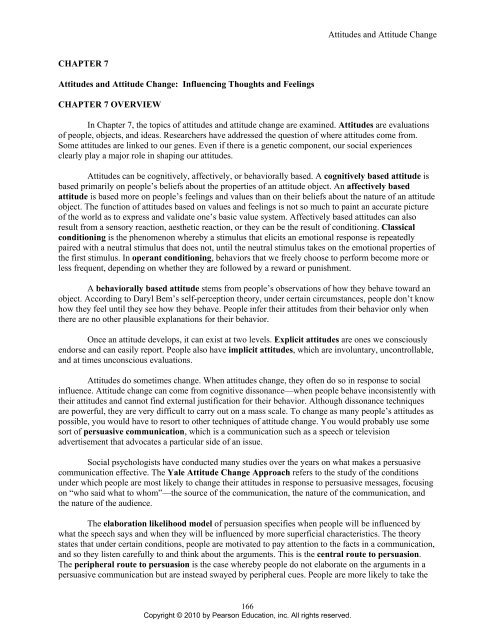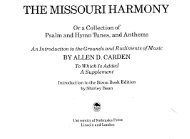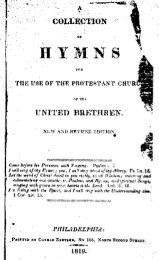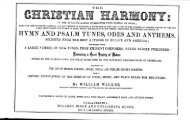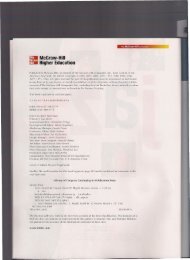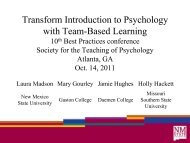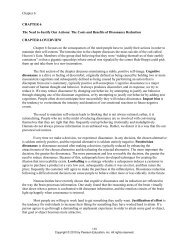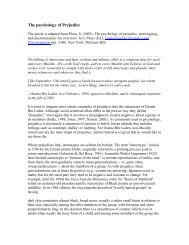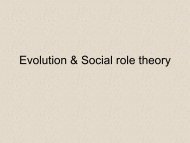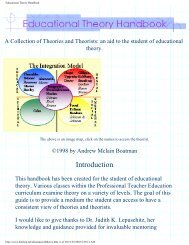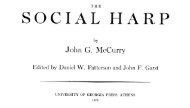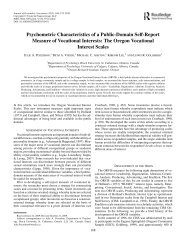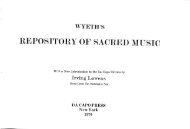Attitudes and Attitude Change CHAPTER 7 Attitudes and Attitude ...
Attitudes and Attitude Change CHAPTER 7 Attitudes and Attitude ...
Attitudes and Attitude Change CHAPTER 7 Attitudes and Attitude ...
Create successful ePaper yourself
Turn your PDF publications into a flip-book with our unique Google optimized e-Paper software.
<strong>CHAPTER</strong> 7<br />
<strong><strong>Attitude</strong>s</strong> <strong>and</strong> <strong>Attitude</strong> <strong>Change</strong>: Influencing Thoughts <strong>and</strong> Feelings<br />
<strong>CHAPTER</strong> 7 OVERVIEW<br />
166<br />
Copyright © 2010 by Pearson Education, inc. All rights reserved.<br />
<strong><strong>Attitude</strong>s</strong> <strong>and</strong> <strong>Attitude</strong> <strong>Change</strong><br />
In Chapter 7, the topics of attitudes <strong>and</strong> attitude change are examined. <strong><strong>Attitude</strong>s</strong> are evaluations<br />
of people, objects, <strong>and</strong> ideas. Researchers have addressed the question of where attitudes come from.<br />
Some attitudes are linked to our genes. Even if there is a genetic component, our social experiences<br />
clearly play a major role in shaping our attitudes.<br />
<strong><strong>Attitude</strong>s</strong> can be cognitively, affectively, or behaviorally based. A cognitively based attitude is<br />
based primarily on people’s beliefs about the properties of an attitude object. An affectively based<br />
attitude is based more on people’s feelings <strong>and</strong> values than on their beliefs about the nature of an attitude<br />
object. The function of attitudes based on values <strong>and</strong> feelings is not so much to paint an accurate picture<br />
of the world as to express <strong>and</strong> validate one’s basic value system. Affectively based attitudes can also<br />
result from a sensory reaction, aesthetic reaction, or they can be the result of conditioning. Classical<br />
conditioning is the phenomenon whereby a stimulus that elicits an emotional response is repeatedly<br />
paired with a neutral stimulus that does not, until the neutral stimulus takes on the emotional properties of<br />
the first stimulus. In operant conditioning, behaviors that we freely choose to perform become more or<br />
less frequent, depending on whether they are followed by a reward or punishment.<br />
A behaviorally based attitude stems from people’s observations of how they behave toward an<br />
object. According to Daryl Bem’s self-perception theory, under certain circumstances, people don’t know<br />
how they feel until they see how they behave. People infer their attitudes from their behavior only when<br />
there are no other plausible explanations for their behavior.<br />
Once an attitude develops, it can exist at two levels. Explicit attitudes are ones we consciously<br />
endorse <strong>and</strong> can easily report. People also have implicit attitudes, which are involuntary, uncontrollable,<br />
<strong>and</strong> at times unconscious evaluations.<br />
<strong><strong>Attitude</strong>s</strong> do sometimes change. When attitudes change, they often do so in response to social<br />
influence. <strong>Attitude</strong> change can come from cognitive dissonance—when people behave inconsistently with<br />
their attitudes <strong>and</strong> cannot find external justification for their behavior. Although dissonance techniques<br />
are powerful, they are very difficult to carry out on a mass scale. To change as many people’s attitudes as<br />
possible, you would have to resort to other techniques of attitude change. You would probably use some<br />
sort of persuasive communication, which is a communication such as a speech or television<br />
advertisement that advocates a particular side of an issue.<br />
Social psychologists have conducted many studies over the years on what makes a persuasive<br />
communication effective. The Yale <strong>Attitude</strong> <strong>Change</strong> Approach refers to the study of the conditions<br />
under which people are most likely to change their attitudes in response to persuasive messages, focusing<br />
on “who said what to whom”—the source of the communication, the nature of the communication, <strong>and</strong><br />
the nature of the audience.<br />
The elaboration likelihood model of persuasion specifies when people will be influenced by<br />
what the speech says <strong>and</strong> when they will be influenced by more superficial characteristics. The theory<br />
states that under certain conditions, people are motivated to pay attention to the facts in a communication,<br />
<strong>and</strong> so they listen carefully to <strong>and</strong> think about the arguments. This is the central route to persuasion.<br />
The peripheral route to persuasion is the case whereby people do not elaborate on the arguments in a<br />
persuasive communication but are instead swayed by peripheral cues. People are more likely to take the
Chapter 7<br />
central route if they are motivated <strong>and</strong> have the ability to pay attention to the facts. Motivation is higher<br />
when the communication is personally relevant. People’s motivation to pay attention to a speech depends<br />
on their personality. Some people enjoy thinking things through more than others do; they are said to be<br />
high in the need for cognition. People high in need for cognition are more likely to pay close attention to<br />
relevant arguments, whereas people low in need for cognition are more likely to rely on peripheral cues. It<br />
is more difficult to pay attention to a communication if we are tired, distracted, or if the issue is too<br />
complex <strong>and</strong> hard to evaluate. People who base their attitudes on a careful analysis of the arguments will<br />
be more likely to maintain this attitude over time, more likely to behave consistently with this attitude,<br />
<strong>and</strong> more resistant to counterpersuasion than people who base their attitudes on peripheral cues.<br />
To get people to consider carefully constructed arguments you have to get their attention. One<br />
way to get people’s attention is to scare them. A fear-arousing communication is a persuasive message<br />
that attempts to change people’s attitudes by arousing their fears. The effectiveness of fear-arousing<br />
communication depends on whether the fear influences people’s ability to pay attention to <strong>and</strong> process the<br />
arguments in a message. If a moderate amount of fear is created <strong>and</strong> people believe that listening to the<br />
message will teach them how to reduce this fear, they will be motivated to analyze the message carefully<br />
<strong>and</strong> will likely change their attitudes via the central route.<br />
Another way in which emotions can cause attitude change is by acting as a signal for how we feel<br />
about something. According to the heuristic-systematic model of persuasion, when people take the<br />
peripheral route to persuasion, they often use heuristics. Our emotions <strong>and</strong> moods can themselves act as<br />
heuristics to determine our attitudes. The only problem is that sometimes it is difficult to tell where our<br />
feelings come from. We may misattribute feelings created by one source to another source.<br />
The success of various attitude change techniques depends on the type of attitude we are trying to<br />
change. Several studies have shown that if an attitude is cognitively based, try to change it with rational<br />
arguments; if it is affectively based, try to change it with emotional appeals. Advertisements are more<br />
effective when they emphasize the attitudes of the culture they are trying to influence. Anything you can<br />
do to increase people's confidence in their thoughts about your message will make it more effective, as<br />
long as your arguments are strong <strong>and</strong> convincing.<br />
The next section of the chapter discusses resisting persuasive messages. <strong>Attitude</strong> inoculation<br />
refers to making people immune to attempts to change their attitudes by initially exposing them to small<br />
doses of the arguments against their positions. Being alert to product placement can also aid in resisting<br />
persuasive messages. Products are often shown in television shows <strong>and</strong> movies. They seem to be simply<br />
part of the show but they are really placed in these programs as advertisements. One reason that product<br />
placement may be so successful is that people do not realize that someone is trying to influence their<br />
attitudes <strong>and</strong> behavior. Warning people about an upcoming attempt to change their attitudes makes them<br />
less susceptible to that attempt. <strong>Attitude</strong> inoculation has been used to help adolescents to resist pressure<br />
from peers to smoke.<br />
It is important not to use too heavy a h<strong>and</strong> when trying to immunize people against assaults on<br />
their attitudes. There is harm to administering strong prohibitions—the stronger they are, the more likely<br />
they will boomerang, causing an increase in interest in the prohibited activity. According to reactance<br />
theory, people do not like to feel that their freedom to do or think whatever they want is being threatened.<br />
When they feel that their freedom is threatened, an unpleasant state of reactance is aroused, <strong>and</strong> people<br />
can reduce this reactance by performing the threatened behavior.<br />
The next section of the chapter addresses the question “When will attitudes predict behavior?”<br />
The relationship between attitudes <strong>and</strong> behavior is not simple. <strong><strong>Attitude</strong>s</strong> will predict spontaneous<br />
behaviors only when they are highly accessible to people. <strong>Attitude</strong> accessibility refers to the strength of<br />
167<br />
Copyright © 2010 by Pearson Education, inc. All rights reserved.
168<br />
Copyright © 2010 by Pearson Education, inc. All rights reserved.<br />
<strong><strong>Attitude</strong>s</strong> <strong>and</strong> <strong>Attitude</strong> <strong>Change</strong><br />
the association between an object <strong>and</strong> an evaluation of it, which is typically measured by the speed with<br />
which people can report how they feel about an issue or object. The best-known theory of how attitudes<br />
predict deliberate behaviors is the theory of planned behavior. According to this theory, when people<br />
have time to contemplate how they are going to behave, the best predictor of their behavior is their<br />
intention, which is determined by three things: their attitudes toward the specific behavior, their<br />
subjective norms, <strong>and</strong> their perceived behavioral control.<br />
The final section of the chapter discusses the power of advertising. Most people think that<br />
advertising works on everyone but themselves. People are influenced by advertisements more than they<br />
think. If advertisers are trying to change an affectively based attitude, then it is best to fight emotions with<br />
emotions. If people’s attitudes are more cognitively based, we need to ask an additional question: How<br />
personally relevant is the issue? If you are dealing with a cognitively based attitude that is not of direct<br />
personal relevance, you might succeed in changing their attitudes via the peripheral route, but this type of<br />
attitude change tends not to be long-lasting. The trick here is to make your product personally relevant.<br />
Many advertisements also try to make people’s attitudes more affectively based by associating the<br />
product with important emotions <strong>and</strong> values.<br />
Subliminal messages are words or pictures that are not consciously perceived but may<br />
nevertheless influence people’s judgments, attitudes, <strong>and</strong> behaviors. Subliminal messages can be auditory<br />
as well. There is no evidence that the types of subliminal messages encountered in everyday life have any<br />
influence on people’s behavior. There is evidence for subliminal effects in carefully controlled laboratory<br />
studies. To get subliminal effects, researchers have to make sure that the illumination of the room is just<br />
right, that people are seated just the right distance from a viewing screen, <strong>and</strong> that nothing else is<br />
occurring to distract them as the subliminal stimuli are flashed. Even in the laboratory, there is no<br />
evidence that subliminal messages can get people to act counter to their wishes, values, or personalities.<br />
Ads are more powerful when people consciously perceive them. Advertising influences more<br />
than just our consumer attitudes. Advertisements transmit cultural stereotypes in their words <strong>and</strong> images,<br />
subtly linking products with desired images. Gender stereotypes are particularly pervasive in advertising<br />
imagery. The stereotypes conveyed in advertisements are far from harmless. The media can have<br />
powerful effects on people's attitudes, both directly <strong>and</strong> indirectly.<br />
<strong>CHAPTER</strong> 7 OUTLINE<br />
I. The Nature <strong>and</strong> Origin of <strong><strong>Attitude</strong>s</strong><br />
• Social psychologists define an attitude as an enduring evaluation, positive or negative, of people,<br />
objects, or ideas.<br />
A. Where Do <strong><strong>Attitude</strong>s</strong> Come From?<br />
• Tesser (1993) suggests that some attitudes are linked to our genes. Evidence for this is based on the<br />
finding that identical twins raised apart (<strong>and</strong> not knowing of each other) have more similar attitudes to<br />
each other than do fraternal twins. <strong>Attitude</strong> similarity is probably mediated indirectly by similarity of<br />
temperament <strong>and</strong> personality.<br />
• Even if there is a genetic component, social experience clearly plays a large role in shaping<br />
attitudes.<br />
• Although all attitudes have the three components, any given attitude can be based more on one<br />
component than another.
Chapter 7<br />
1. Cognitively Based <strong><strong>Attitude</strong>s</strong><br />
• Cognitively based attitudes are based primarily on a person’s beliefs about the properties of<br />
the attitude object; their function is “object appraisal,” meaning that people classify objects<br />
according to the rewards or punishments they provide.<br />
2. Affectively Based <strong><strong>Attitude</strong>s</strong><br />
• Affectively based attitudes are based more on people’s feelings <strong>and</strong> values than on their<br />
beliefs. Their function may be value-expressive. Thus, attitudes towards political c<strong>and</strong>idates are<br />
generally more affectively than cognitively based.<br />
• Other affectively based attitudes can be the result of a sensory reaction or of conditioning.<br />
• Classical conditioning is learning by association (a stimulus that elicits an emotional response<br />
is repeatedly experienced along with a neutral stimulus that does not, until the neutral stimulus<br />
takes on the emotional properties of the first stimulus). Operant conditioning is the case<br />
whereby behaviors that people freely choose to perform increase or decrease in frequency,<br />
depending on whether they are followed by positive reinforcement or punishment (see Figure 7.1,<br />
p. 193).<br />
• Affectively based attitudes have these features in common: they do not result from rational<br />
examination of the issues; they are not governed by logic; <strong>and</strong> they are often linked to people’s<br />
values.<br />
3. Behaviorally Based <strong><strong>Attitude</strong>s</strong><br />
• Behaviorally based attitudes are based on self-perception of one’s own behavior when the<br />
initial attitude is weak or ambiguous.<br />
B. Explicit versus Implicit <strong><strong>Attitude</strong>s</strong><br />
• Once an attitude develops, it can exist at two levels. Explicit attitudes are ones we consciously<br />
endorse <strong>and</strong> can easily report. Implicit attitudes on the other h<strong>and</strong>, are involuntary, uncontrollable,<br />
<strong>and</strong> at times, unconscious evaluations.<br />
• One of the most popular methods to measure implicit attitudes is the Implicit Association Test or<br />
IAT, in which people categorize words or pictures on a computer. You can find out more about this<br />
test at https://implicit.harvard.edu/implicit.<br />
C. How Do <strong><strong>Attitude</strong>s</strong> <strong>Change</strong>?<br />
• <strong><strong>Attitude</strong>s</strong> may be very changeable; changes are frequently due to social influence.<br />
D. Changing <strong><strong>Attitude</strong>s</strong> by Changing Behavior: Cognitive Dissonance Theory Revisited<br />
• <strong><strong>Attitude</strong>s</strong> may change due to the cognitive dissonance resulting from behavior that appears to have<br />
insufficient internal justification; changing the attitude to correspond with the behavior provides an<br />
internal justification.<br />
• Counterattitudinal advocacy is hard to induce on a mass scale, so people usually attempt to change<br />
the attitudes of the masses through persuasive communication.<br />
• Persuasive communication is communication advocating a particular side of an issue.<br />
E. Persuasive Communications <strong>and</strong> <strong>Attitude</strong> <strong>Change</strong><br />
• The study of persuasive communication by social psychologists began under Hovl<strong>and</strong> with the Yale<br />
<strong>Attitude</strong> <strong>Change</strong> approach, which examines the conditions under which people are most likely to<br />
change their attitude in response to a persuasive message <strong>and</strong> which focuses on who (the source of the<br />
communication) said what (the communication itself) to whom (the audience) (Figure 7.2, p. 185).<br />
• A problem with the Yale <strong>Attitude</strong> <strong>Change</strong> approach is that it does not define the conditions under<br />
which one aspect of a communication should be emphasized over others.<br />
1. The Central <strong>and</strong> Peripheral Routes to Persuasion<br />
• Two influential theories, Chaiken’s heuristic-systematic persuasion model <strong>and</strong> Petty <strong>and</strong><br />
Cacioppo’s elaboration likelihood model have tried to specify when people will be more<br />
169<br />
Copyright © 2010 by Pearson Education, inc. All rights reserved.
170<br />
Copyright © 2010 by Pearson Education, inc. All rights reserved.<br />
<strong><strong>Attitude</strong>s</strong> <strong>and</strong> <strong>Attitude</strong> <strong>Change</strong><br />
influenced by message content <strong>and</strong> when they will be more influenced by superficial<br />
characteristics of the message.<br />
• Both theories state that under certain conditions, people are motivated to pay attention to <strong>and</strong><br />
think about (elaborate on) the facts in a message. Under other conditions, people are not<br />
motivated to pay attention to the facts a message presents <strong>and</strong> only attend to superficial<br />
characteristics.<br />
• More specifically, the elaboration likelihood model states that there are two ways in which<br />
persuasive communications can cause attitude change. The central route to persuasion is the<br />
case whereby people elaborate on a persuasive communication, listening carefully to <strong>and</strong> thinking<br />
about the arguments; this occurs when people have both the ability <strong>and</strong> the motivation to listen<br />
carefully to a communication. The peripheral route to persuasion is the case whereby people do<br />
not elaborate on the arguments in a persuasive communication but are instead swayed by<br />
peripheral cues or surface characteristics (e.g., who gave the speech).<br />
• The audience’s motivation to listen <strong>and</strong> ability to listen determine which route they will take<br />
(Figure 7.3, p. 186).<br />
2. The Motivation to Pay Attention to the Arguments<br />
• The personal relevance of a message influences motivation; thus, when a message is relevant,<br />
the amount of persuasion depends on argument quality.<br />
• Petty, Cacioppo, & Goldman (1981) had students listen to a persuasive message advocating a<br />
senior comprehensive exam. Personal relevance was manipulated by saying that the exam was<br />
considered for next year or for ten years hence. Also, the message contained either strong or weak<br />
arguments <strong>and</strong> was presented by either a high or low prestige source. They found that under high<br />
relevance, people were more influenced by strong than by weak arguments, regardless of source<br />
prestige; while under low relevance, people were influenced by the prestige of the speaker more<br />
than by the quality of the arguments (Figure 7.4, p. 187).<br />
• People’s motivation to listen carefully to message content may also depend on their level of<br />
need for cognition, the extent to which they seek out <strong>and</strong> think about information in their social<br />
worlds.<br />
3. The Ability to Pay Attention to the Arguments<br />
• People’s ability to attend to message content may be influenced by tiredness, outside distracters,<br />
or by the complexity of the message.<br />
4. How to Achieve Long-Lasting <strong>Attitude</strong> <strong>Change</strong><br />
• <strong>Attitude</strong> change will be more long-lasting if it occurs through the central route; thus develop<br />
strong arguments <strong>and</strong> get people to think about them by making the issue personally relevant.<br />
F. Emotion <strong>and</strong> <strong>Attitude</strong> <strong>Change</strong><br />
• In order to get people to use the central processing route, you need to get their attention. This can be<br />
done by playing to their emotions.<br />
1. Fear-Arousing Communications<br />
• Fear-arousing communications are persuasive messages that attempt to change people’s<br />
attitudes by arousing their fears. They are most effective if they induce a moderate amount of fear<br />
<strong>and</strong> if people believe that listening to the message will provide them with actions they can take to<br />
reduce this fear. If the message is too scary or not scary enough, it will fail (Figure 7.5, p. 190).<br />
2. Emotion as a Heuristic<br />
• Chaiken’s heuristic-systematic model of persuasion states that there are two ways in which<br />
persuasive communications can cause attitude change; people either systematically process the<br />
merits of the arguments, or they use mental shortcuts (heuristics). Thus when people take the<br />
peripheral route to persuasion they often use heuristics, e.g., “(Message) length equals strength”<br />
or “Experts are always right.”<br />
• Emotions <strong>and</strong> moods themselves can be used as a heuristic; we ask ourselves “How do I feel<br />
about it?” <strong>and</strong> if we feel good, we infer we have a positive attitude. This can get us into trouble if
Chapter 7<br />
the good feelings are due to something other than the attitude object <strong>and</strong> we make a misattribution<br />
that the attitude object is the source.<br />
3. Emotion <strong>and</strong> Different Types of <strong><strong>Attitude</strong>s</strong><br />
• Studies suggest that it is most effective to try to change cognitively based attitudes by using the<br />
central route to persuasion, but to change affectively based attitudes by using emotional<br />
persuasion.<br />
• Shavitt (1990) found that people were most persuaded by informational, utilitarian ads for<br />
products (e.g., air conditioners) towards which they had cognitively based attitudes <strong>and</strong> by value<br />
or social-identity laden ads for products (e.g., perfume) towards which they have affectively<br />
based attitudes (Figure 7.6, p. 192).<br />
4. Culture <strong>and</strong> Different Types of <strong><strong>Attitude</strong>s</strong><br />
• Han <strong>and</strong> Shavitt (1994) found that Americans were most influenced by ads that stressed<br />
independence <strong>and</strong> self-improvement while Koreans were most influenced by ads (for the same<br />
product) that stressed interdependence <strong>and</strong> social st<strong>and</strong>ing.<br />
• In general, advertisements work best if they are tailored to the kind of attitude they are trying to<br />
change.<br />
G. Confidence in One's Thoughts <strong>and</strong> <strong>Attitude</strong> <strong>Change</strong><br />
• Anything you can do to increase people's confidence in their thoughts about your message will make<br />
it more effective, as long as your arguments are strong <strong>and</strong> convincing.<br />
III. Resisting Persuasive Messages<br />
A. <strong>Attitude</strong> Inoculation<br />
• One way to bolster people against persuasion attempts is to have them consider the arguments for<br />
<strong>and</strong> against their attitude before somebody attacks it.<br />
•The attitude inoculation procedure does this by exposing people to a small dose of the argument<br />
against their position; this induced them to counterargue <strong>and</strong> provides a “vaccination” that helps<br />
people ward off later, stronger influence attempts.<br />
B. Be Alert to Product Placement<br />
Companies pay the makers of a TV show to incorporate their product into the script, which is called<br />
product placement. Several studies have found that warning people about an upcoming product<br />
placement makes them less susceptible to that persuasive attempt.<br />
C. Resisting Peer Pressure<br />
• Several programs have tried to prevent smoking in adolescents by exposing them to mild versions of<br />
attempts to get them to smoke <strong>and</strong> having them role play counteracting these pressures. These<br />
programs appear successful in reducing teen smoking.<br />
D. When Persuasion Attempts Boomerang: Reactance Theory<br />
• It is important not to use too heavy a h<strong>and</strong> when trying to immunize people against assaults on their<br />
attitudes. If you administer too strong a prohibition, the prohibition may boomerang <strong>and</strong> lead to an<br />
increase in the prohibited activity. Reactance theory explains this by saying that strong prohibitions<br />
threaten a person’s feeling of freedom, <strong>and</strong> the boomerang is an attempt to restore that feeling of<br />
freedom.<br />
• Pennebaker <strong>and</strong> S<strong>and</strong>ers (1976) found that graffiti was reduced more by a sign with a mild<br />
prohibition than by a sign with a strong one.<br />
IV. When Will <strong><strong>Attitude</strong>s</strong> Predict Behavior?<br />
• People’s behavior does not always correspond to their attitude.<br />
171<br />
Copyright © 2010 by Pearson Education, inc. All rights reserved.
172<br />
Copyright © 2010 by Pearson Education, inc. All rights reserved.<br />
<strong><strong>Attitude</strong>s</strong> <strong>and</strong> <strong>Attitude</strong> <strong>Change</strong><br />
• LaPiere did a classic field study in the 1930s, where he found that hotel <strong>and</strong> restaurants served a Chinese<br />
couple despite their written statements that they would not do so.<br />
• Later research reveals that attitudes do predict behavior, but only under certain conditions.<br />
A. Predicting Spontaneous Behaviors<br />
• People’s attitudes will predict/be consistent with their spontaneous behaviors when the attitudes are<br />
highly accessible. <strong>Attitude</strong> accessibility refers to the strength of the association between an attitude<br />
object <strong>and</strong> a person’s evaluation of that object, measured by the speed with which people can report<br />
how they feel about the object. If the attitudes are not highly accessible, arbitrary aspects of the<br />
situation will tend to determine behavior.<br />
B. Predicting Deliberative Behaviors<br />
• Ajzen <strong>and</strong> Fishbein’s theory of planned behavior is a theory of how attitudes predict planned,<br />
deliberative behavior; according to this theory the best predictors of these behaviors are the person’s<br />
specific attitudes, his or her subjective norms, <strong>and</strong> their perceived behavioral control (Figure 7.7, p.<br />
213).<br />
1. Specific <strong><strong>Attitude</strong>s</strong><br />
• The attitude that is important is not a general attitude but their attitude towards the specific<br />
behavior in question. For example, Davidson <strong>and</strong> Jaccard (1979) showed that married women’s<br />
use of birth control pills was much better predicted by their attitude towards using the pills during<br />
the next two years than it was by their attitudes towards the pills or towards birth control (Table<br />
7.1, p. 213).<br />
2. Subjective norms<br />
• People’s beliefs about how those they care about will view the behavior in question. Asking<br />
people about their subjective norms increases the ability to predict planned, deliberative<br />
behaviors.<br />
3. Perceived behavioral control<br />
• The ease with which people believe they can perform the behavior. If people think it is easy to<br />
perform the behavior, they are more likely to form a strong intention to do it.<br />
• Considerable research supports the idea that asking people about these three determinants of<br />
their intentions increases the ability to predict their planned, deliberative behaviors.<br />
V. The Power of Advertising<br />
• Wilson <strong>and</strong> Brekke (1994) found that most people think advertising works on everybody but<br />
themselves.<br />
• Contrary to such beliefs, the evidence indicates that advertising works, in the sense that sales increase.<br />
• The best evidence that advertising works comes from studies using split cable market tests, where<br />
advertisers work in conjunction with cable companies <strong>and</strong> stores to show ads to a r<strong>and</strong>omly selected<br />
group of people <strong>and</strong> see whether these people are more likely to buy the product.<br />
• Ads work particularly well for new products.<br />
A. How Advertising Works<br />
• Advertisers should consider the kind of attitude they are trying to change. If they are trying to<br />
change an affectively based attitude, it is best to take an emotional approach (e.g., associate feelings<br />
of excitement, energy, <strong>and</strong> sexual attractiveness with the br<strong>and</strong>). If they are trying to change a<br />
cognitively based attitude, they also need to consider the personal relevance of the attitude.<br />
• If a product is personally relevant, the best way to change it is through strong arguments; if a<br />
product is not personally relevant, advertising may attempt to make it seem so (e.g., Gerald Lambert<br />
created the term “halitosis” to increase sales for Listerine).
Chapter 7<br />
B. Subliminal Advertising: A Form of Mind Control?<br />
• Subliminal messages are words or pictures that are not consciously perceived but that supposedly<br />
influence people’s judgments, attitudes, <strong>and</strong> behaviors.<br />
• In the 1950s, J. Vicary convinced a movie theater to flash the subliminal messages “Drink Coca-<br />
Cola” <strong>and</strong> “Eat popcorn” during a movie, <strong>and</strong> he claimed large increases in sales from this<br />
manipulation, provoking a large public outcry. Since then, audiotapes with subliminal messages to<br />
help people make personal changes have developed a large market.<br />
1. Debunking the Claims about Subliminal Advertising<br />
• Although most people believe that subliminal messages work, <strong>and</strong> there have been many<br />
popular attempts to indicate that they do, controlled studies do not indicate that they are effective<br />
when used in everyday life.<br />
2. Laboratory Evidence for Subliminal Influence<br />
• There is some evidence that subliminal messages may be effective in controlled, laboratory<br />
studies. Karremans <strong>and</strong> colleagues (2006) exposed students to subliminal flashes of the words<br />
"Lipton Ice" or a nonsense word made of the same letters. All students were asked whether they<br />
would prefer Lipton Ice or a br<strong>and</strong> of Dutch mineral water if they were offered a drink at that<br />
moment. If students were not thirsty at the time, the subliminal flashes had no effect on their<br />
drink preference. But if students were thirsty, those who had seen the subliminal flashes of<br />
"Lipton Ice" were significantly more likely to choose that drink than were students who had seen<br />
subliminal flashes of nonsense words.<br />
• Subliminal effects only occur under very carefully controlled conditions <strong>and</strong> do not override<br />
people’s wishes <strong>and</strong> desires.<br />
C. Advertising, Cultural Stereotypes, <strong>and</strong> Social Behavior<br />
• Ads are more powerful when people consciously perceive them.<br />
• Advertisements transmit cultural stereotypes in their words <strong>and</strong> images, subtly linking products<br />
with desired images (e.g., Marlboro ads linking cigarettes with the rugged macho Marlboro Man).<br />
• Gender stereotypes are particularly pervasive in advertising imagery. Men are portrayed as<br />
doers <strong>and</strong> women as observers.<br />
• Stereotypes conveyed in advertisements are far from harmless. The media can have powerful<br />
effects on people's attitudes, both directly <strong>and</strong> indirectly.<br />
LEARNING OBJECTIVES<br />
After reading Chapter 7, you should be able to do the following:<br />
1. Define an attitude <strong>and</strong> identify its components. Discuss the differences between cognitively based<br />
attitudes <strong>and</strong> affectively based attitudes. (pp. 178-181)<br />
2. Explain how affectively based attitudes are formed via classical conditioning <strong>and</strong> operant<br />
conditioning. (pp. 180-181)<br />
3. Define a behaviorally based attitude <strong>and</strong> discuss how it is formed. (pp. 181-182)<br />
4. Distinguish between explicit <strong>and</strong> implicit attitudes. (p. 182)<br />
5. Discuss the role of cognitive dissonance in attitude change. Explain what is meant by internal<br />
justification. Identify what you would need to do if you wanted to change attitudes on a mass<br />
scale. (pp. 183-184)<br />
173<br />
Copyright © 2010 by Pearson Education, inc. All rights reserved.
174<br />
Copyright © 2010 by Pearson Education, inc. All rights reserved.<br />
<strong><strong>Attitude</strong>s</strong> <strong>and</strong> <strong>Attitude</strong> <strong>Change</strong><br />
6. Describe the Yale <strong>Attitude</strong> <strong>Change</strong> approach. Identify <strong>and</strong> define the three factors in an influence<br />
setting emphasized by this approach. Provide examples of each factor. Identify a problem with<br />
the Yale <strong>Attitude</strong> <strong>Change</strong> Approach. (p. 184)<br />
7. Describe the aim of attitude change models like Petty <strong>and</strong> Cacioppo’s elaboration likelihood<br />
model <strong>and</strong> Chaiken’s heuristic-systematic model of persuasion. (p. 185 & 191)<br />
8. Identify the two routes to persuasion described in the elaboration likelihood model. Identify the<br />
factors that determine the route people take. Identify factors that increase people’s motivation <strong>and</strong><br />
ability to pay attention to the arguments. Discuss how attitudes changed by the central route to<br />
persuasion differ from attitudes changed by the peripheral route. (pp. 184-185 & 189)<br />
9. Discuss the influence of emotion on persuasion. Identify the role of fear-arousing<br />
communications in persuasion. Describe the conditions under which fear appeals foster or inhibit<br />
attitude change. (pp. 189-191)<br />
10. Describe the process whereby emotions act as heuristics to persuasion according to the heuristicsystematic<br />
model of persuasion. Identify the problem with using emotions as a guide to attitude<br />
formation. (p. 191)<br />
11. Identify the most effective means of changing affectively <strong>and</strong> cognitively based attitudes. (p. 192)<br />
12. Discuss cross-cultural differences in the kinds of attitudes people have <strong>and</strong> how these attitudes are<br />
changed. (p. 193)<br />
13. Identify the purpose of attitude inoculation. Describe product placement <strong>and</strong> what makes it<br />
effective. Discuss how attitude inoculation is used to help teens resist peer pressure. Discuss the<br />
role of reactance when persuasion attempts “boomerang.” (pp. 194-197)<br />
14. Describe the conditions under which attitudes predict spontaneous <strong>and</strong> deliberative behaviors.<br />
Discuss the role of attitude accessibility in predicting spontaneous behaviors. (pp. 197-198)<br />
15. Discuss the role of people’s intentions <strong>and</strong> other variables outlined in the theory of planned<br />
behavior in predicting deliberative behaviors. Define <strong>and</strong> explain the relationship between<br />
attitudes toward behaviors, subjective norms, <strong>and</strong> perceived behavioral control that is outlined in<br />
the theory of planned behavior. (pp. 198-199)<br />
16. Identify the most effective advertising strategies for changing affectively <strong>and</strong> cognitively based<br />
attitudes when personal relevance is high, for changing cognitively based attitudes when personal<br />
relevance is low, <strong>and</strong> for selling bl<strong>and</strong> products that evoke few emotions. (pp. 200-202)<br />
17. Discuss the controversial topic of subliminal advertising <strong>and</strong> evaluate the claim that subliminal<br />
messages are effective. Describe evidence for subliminal influence from laboratory experiments.<br />
Identify what research has found regarding the power of advertising that is consciously perceived.<br />
(pp. 202-204)<br />
18. Discuss how advertising transmits information regarding cultural stereotypes. (pp. 204-205)
Chapter 7<br />
KEY TERMS<br />
1. __________ Evaluations of people, objects, <strong>and</strong> ideas. (p. 178)<br />
2. __________ An attitude based primarily on people’s beliefs about the properties of an attitude<br />
object. (p. 179)<br />
3. __________ An attitude based more on people’s feelings <strong>and</strong> values than on their beliefs<br />
about the nature of an attitude object. (p. 179)<br />
4. __________ The phenomenon whereby a stimulus that elicits an emotional response is<br />
repeatedly paired with a neutral stimulus that does not, until the neutral stimulus takes on the emotional<br />
properties of the first stimulus. (p. 180)<br />
5. __________ The phenomenon whereby behaviors that people freely choose to perform<br />
increase or decrease in frequency, depending on whether they are followed by positive reinforcement or<br />
punishment. (p. 180)<br />
6. __________ An attitude based on observations of how one behaves toward an attitude object.<br />
(p. 181)<br />
7. __________ <strong><strong>Attitude</strong>s</strong> that we consciously endorse <strong>and</strong> can easily report. (p. 182)<br />
8. __________ <strong><strong>Attitude</strong>s</strong> that are involuntary, uncontrollable, <strong>and</strong> at times unconscious. (p. 182)<br />
9. __________ Communication advocating a particular side of an issue. (p. 184)<br />
10. __________ The study of the conditions under which people are most likely to change their<br />
attitudes in response to persuasive messages, focusing on “who said what to whom”—the source of the<br />
communication, the nature of the communication, <strong>and</strong> the nature of the audience. (p. 184)<br />
11. __________ A model explaining two ways in which persuasive communications can cause<br />
attitude change: centrally, when people are motivated <strong>and</strong> have the ability to pay attention to the<br />
arguments in the communication, <strong>and</strong> peripherally, when people do not pay attention to the arguments,<br />
but are instead swayed by surface characteristics. (p. 185)<br />
12. __________ The case whereby people elaborate on a persuasive communication, listening<br />
carefully to <strong>and</strong> thinking about the arguments. (p. 185)<br />
13. __________ The case whereby people do not elaborate on the arguments in a persuasive<br />
communication but are instead swayed by peripheral cues. (p. 187)<br />
14. __________ A personality variable reflecting the extent to which people engage in <strong>and</strong> enjoy<br />
effortful cognitive activities. (p. 188)<br />
15. __________ Persuasive messages that attempt to change people’s attitudes by arousing their<br />
fears. (p. 190)<br />
16. __________ An explanation of the two ways in which persuasive communications can cause<br />
attitude change: either systematically processing the merits of the arguments or using mental shortcuts<br />
(heuristics). (p. 191)<br />
175<br />
Copyright © 2010 by Pearson Education, inc. All rights reserved.
176<br />
Copyright © 2010 by Pearson Education, inc. All rights reserved.<br />
<strong><strong>Attitude</strong>s</strong> <strong>and</strong> <strong>Attitude</strong> <strong>Change</strong><br />
17. __________ Making people immune to attempts to change their attitudes by initially exposing<br />
them to small doses of the arguments against their position. (p. 194)<br />
18. __________ The idea that when people feel their freedom to perform a certain behavior is<br />
threatened, an unpleasant state of reactance is aroused, which they can reduce by performing the<br />
threatened behavior. (p. 196)<br />
19. __________ The strength of the association between an attitude object <strong>and</strong> a person’s<br />
evaluation of that object, measured by the speed with which people can report how they feel about the<br />
object. (p. 198)<br />
20. __________ The idea that the best predictors of a person’s planned, deliberate behaviors are<br />
the person’s attitudes toward specific behaviors, subjective norms, <strong>and</strong> perceived behavioral control. (p.<br />
198)<br />
21. __________ Words or pictures that are not consciously perceived but may nevertheless<br />
influence people’s judgments, attitudes, <strong>and</strong> behaviors. (p. 202)<br />
PRACTICE TEST<br />
GUIDED REVIEW<br />
1. Responding to a “puppies for sale” ad, you arrive at the seller’s home <strong>and</strong> immediately fall in<br />
love with the first puppy you see. The component of your attitude toward the puppy that is<br />
exemplified by such a reaction is called the ____ component.<br />
a) behavioral<br />
b) cognitive<br />
c) affective<br />
d) heuristic<br />
2. While studying the conditions under which people are most likely to be influenced by persuasive<br />
communications, Hovl<strong>and</strong> <strong>and</strong> colleagues at Yale repeatedly asked:<br />
a) who says what to whom?<br />
b) when will logical arguments persuade people <strong>and</strong> when will more superficial<br />
characteristics do so?<br />
c) why are communications persuasive?<br />
d) what condition produces the most influence?<br />
3. Distraction during a persuasive message <strong>and</strong> message complexity prevent the careful<br />
consideration of relevant arguments by decreasing the:<br />
a) motivation to attend to relevant arguments.<br />
b) ability to attend to relevant arguments.<br />
c) personal relevance of the message.<br />
d) degree of association between message characteristics <strong>and</strong> internal response cues.
Chapter 7<br />
4. Though fear-arousing communications are threatening, people will reduce this threat by changing<br />
their attitudes <strong>and</strong> behaviors only when:<br />
a) the communication produces an extremely high level of fear.<br />
b) the fear-arousing message can be easily ignored.<br />
c) the fear-arousing communication is directed at individuals with high levels of selfesteem.<br />
d) the fear-arousing communication offers suggestions about how to avoid the threat.<br />
5. Children may adopt prejudiced attitudes through operant conditioning if their parents:<br />
a) associate such attitudes with emotionally positive stimuli.<br />
b) punish them for expressing such attitudes.<br />
c) reward them for expressing such attitudes.<br />
d) present arguments favoring such attitudes.<br />
6. Which of the following is true regarding when attitudes will predict spontaneous or deliberative<br />
behaviors?<br />
a) <strong><strong>Attitude</strong>s</strong> will predict spontaneous behaviors when they are very accessible.<br />
b) <strong>Attitude</strong>-behavioral consistency is high among people with accessible attitudes.<br />
c) Deliberate behaviors are predicted by people’s intentions.<br />
d) All the above are true.<br />
7. A personality variable that has been linked to the use of the central route to persuasion is:<br />
a) need for emotion.<br />
b) need for reason.<br />
c) need for explanation.<br />
d) need for cognition.<br />
8. Words or pictures that are not consciously perceived but may be influential are:<br />
a) exceptional messages.<br />
b) subliminal messages.<br />
c) reactance messages.<br />
d) unconscious messages.<br />
9. The theory of planned behavior states that all of the following are predictors of people’s planned,<br />
deliberative behaviors EXCEPT:<br />
a) subjective norms.<br />
b) perceived behavioral control.<br />
c) attitudes toward the specific behavior.<br />
d) social norms.<br />
10. According to Petty <strong>and</strong> Cacioppo’s (1986) elaboration likelihood model, when people are<br />
persuaded by surface characteristics of a message, such as how long the message is, they have<br />
taken the ____ route to persuasion.<br />
a) central<br />
b) peripheral<br />
c) heuristic<br />
d) subjective<br />
177<br />
Copyright © 2010 by Pearson Education, inc. All rights reserved.
11. <strong><strong>Attitude</strong>s</strong> changed by the central route to persuasion are:<br />
a) maintained over time.<br />
b) consistent with behaviors.<br />
c) resistant to counterpersuasion.<br />
d) all the above.<br />
178<br />
Copyright © 2010 by Pearson Education, inc. All rights reserved.<br />
<strong><strong>Attitude</strong>s</strong> <strong>and</strong> <strong>Attitude</strong> <strong>Change</strong><br />
12. Shavitt (1990) presented participants with cognitively or affectively oriented ads for products<br />
about which people had either cognitively or affectively based attitudes. Results indicated that<br />
participants were most influenced by:<br />
a) cognitively based ads.<br />
b) affectively based ads.<br />
c) ads that “matched” the type of attitude they had.<br />
d) cognitively based ads that were self-relevant <strong>and</strong> affectively based ads that were not<br />
relevant.<br />
13. When you encounter an object <strong>and</strong> your attitude toward that object comes immediately to mind,<br />
your attitude is said to be highly:<br />
a) resistant.<br />
b) accessible.<br />
c) deliberative.<br />
d) intentional.<br />
14. After strongly prohibiting the reading of banned books, Professor Jones has noticed an increased<br />
interest by her students in the books. Which of the following theories best explains this outcome?<br />
a) theory of reasoned action<br />
b) elaboration likelihood model<br />
c) reactance theory<br />
d) classical conditioning theory<br />
15. Responses to which of the following questions will best predict whether someone donates clothes<br />
to the Salvation Army next Sunday at noon?<br />
a) “How much are you willing to help others?”<br />
b) “How do you feel about making donations to charities?”<br />
c) “How do you feel about donating clothes to the Salvation Army?”<br />
d) “How do you feel about donating clothes to the Salvation Army next Sunday<br />
at noon?”<br />
16. Rudman <strong>and</strong> colleagues (2007) found evidence that implicit attitudes are rooted more in people's<br />
_____ experiences whereas explicit attitudes are rooted more in their _____ experiences.<br />
a) pleasant; unpleasant<br />
b) unpleasant; pleasant<br />
c) childhood; recent<br />
d) recent; childhood<br />
17. An attitude change theory that states that we can satisfy our need to justify engaging in attitudediscrepant<br />
behaviors by changing our attitudes is:<br />
a) self-evaluation maintenance theory.<br />
b) cognitive dissonance theory.<br />
c) elaboration likelihood theory.<br />
d) self-affirmation theory.
Chapter 7<br />
18. Fear-evoking persuasive appeals fail if they are too strong <strong>and</strong> threatening because:<br />
a) people become defensive.<br />
b) people deny the threat.<br />
c) people will not think rationally about the issue.<br />
d) all the above are reasons.<br />
19. Heuristic processing is to the ____ route to persuasion as systematic processing is to the ____<br />
route to persuasion.<br />
a) primary; secondary<br />
b) secondary; primary<br />
c) peripheral; central<br />
d) central; peripheral<br />
20. Making people immune to persuasion attempts by exposing them to small doses of arguments<br />
against their position is called:<br />
a) attitude inoculation.<br />
b) attitude vaccination.<br />
c) attitude reactance.<br />
d) attitude prevention.<br />
21. Regarding attitude-behavior consistency, it is important to measure people’s beliefs about how<br />
others will view the given behavior. These beliefs are called:<br />
a) subjective norms.<br />
b) objective norms.<br />
c) injunctive norms.<br />
d) social norms.<br />
22. Which of the following is FALSE regarding subliminal messages?<br />
a) There is no evidence that subliminal messages, both those used in everyday life <strong>and</strong> those<br />
manipulated in the lab, influence people’s behavior.<br />
b) Subliminal tapes, for example to boost self-esteem or improve memory, are<br />
ineffective.<br />
c) Ads that are consciously perceived exert more influence on people’s attitudes than do<br />
those that are not consciously perceived.<br />
d) All the above are false.<br />
23. If someone asks you “how much do you like pizza?” you will likely report a(n)<br />
___________________ towards pizza.<br />
a) implicit attitude<br />
b) explicit attitude<br />
c) central attitude<br />
d) peripheral attitude<br />
24. According to the Yale <strong>Attitude</strong> <strong>Change</strong> approach, which of the following is true?<br />
a) Distracted audiences are persuaded less often than are audiences not distracted.<br />
b) People with moderate self-esteem are less persuadable than are people with low or high<br />
self-esteem.<br />
c) It is best to present a one-sided persuasive communication.<br />
d) People are more susceptible to attitude change when they are between the ages of 18 <strong>and</strong><br />
25.<br />
179<br />
Copyright © 2010 by Pearson Education, inc. All rights reserved.
25. An attitude is a(n):<br />
a) behavior following from complex social stimuli.<br />
b) evaluation of people, objects, <strong>and</strong> ideas.<br />
c) influence to the real or imagined presence of others.<br />
d) belief about how other people will view one’s behavior.<br />
180<br />
Copyright © 2010 by Pearson Education, inc. All rights reserved.<br />
<strong><strong>Attitude</strong>s</strong> <strong>and</strong> <strong>Attitude</strong> <strong>Change</strong><br />
26. Participants in a study by Petty et al. (1981) were told that their university was thinking about<br />
requiring senior comprehensive exams either immediately or in 10 years. Participants paid greater<br />
attention to arguments favoring the exams when they believed that the exam policy might take<br />
effect immediately because:<br />
a) the issue was personally relevant.<br />
b) a decision had to be made very soon.<br />
c) the participants knew friends who were seniors.<br />
d) the participants were opposed to the exam policy.<br />
27. When we can find little external justification for behavior that is inconsistent with an attitude,<br />
changing the attitude so that it is consistent with the behavior is one way to reduce:<br />
a) reactance.<br />
b) personal relevance.<br />
c) attitude accessibility.<br />
d) cognitive dissonance.<br />
28. Techniques such as the IAT are useful in assessing:<br />
a) implicit attitudes.<br />
b) explicit attitudes.<br />
c) attitude change following a persuasive appeal.<br />
d) need for cognition.<br />
29. According to the elaboration likelihood model of persuasion, the ____ of persuasive arguments<br />
has more impact when people’s personal involvement in the issue is ____.<br />
a) strength; low<br />
b) strength; high<br />
c) quantity; high<br />
d) both a <strong>and</strong> c<br />
30. Which was NOT an independent variable in Petty, Ciacioppo, <strong>and</strong> Goldman’s (1981) study of<br />
attitudes toward comprehensive exams?<br />
a) source expertise<br />
b) quality of argument<br />
c) personal relevance<br />
d) participants’ attitudes toward comprehensive exams<br />
31. Linda believes that spinach is good for you. This belief represents the _____ component of<br />
Linda’s attitude.<br />
a) affective<br />
b) behavioral<br />
c) cognitive<br />
d) componential
Chapter 7<br />
32. People’s attitudes about appliances such as vacuum cleaners <strong>and</strong> refrigerators are most likely<br />
_____ based.<br />
a) cognitively<br />
b) affectively<br />
c) behavioral<br />
d) dissonance<br />
33. Joe believes he is not prejudiced toward homosexuals, yet he does not want gay couples living in<br />
his neighborhood, or gays or lesbians working in his office building. Joe’s attitude toward<br />
homosexuals is<br />
a) explicit.<br />
b) implicit.<br />
c) central.<br />
d) peripheral.<br />
34. According to the Yale <strong>Attitude</strong> <strong>Change</strong> Approach, speakers are more persuasive if they are only<br />
moderately attractive because we assume they are more intelligent.<br />
a) True<br />
b) False<br />
35. According to the Yale <strong>Attitude</strong> <strong>Change</strong> Approach it is best to give your speech before another<br />
person presenting an opposing viewpoint when<br />
a) your argument is weaker than the other person’s argument.<br />
b) you are giving the speech in the evening when people are beginning to feel tired.<br />
c) there will be a delay between the speeches <strong>and</strong> people will make up their minds<br />
right after hearing the second one.<br />
d) the speeches are to be given back to back <strong>and</strong> there will be a delay before people<br />
have to make up their minds.<br />
36. Who is most likely to pay close attention to an advertisement for children’s aspirin?<br />
a) Mary, who is 50 <strong>and</strong> has never had children<br />
b) Mark <strong>and</strong> Jeanette who are 58 <strong>and</strong> have two grown children<br />
c) Tammy, who has a 4-year-old daughter<br />
d) Tabitha, who is 26-years old <strong>and</strong> just found out she is pregnant for the first time<br />
37. Ron is listening to a speech about a topic that is only slightly relevant to him. Which of the<br />
following is most likely to influence Ron?<br />
a) who the speaker is<br />
b) the strength of the arguments<br />
c) how interesting the speech is<br />
d) how informative the speech is<br />
38. One way in which emotions can cause attitude change is by acting as a signal for how we feel<br />
about something.<br />
a) True<br />
b) False<br />
39. In a study by Han & Shavitt (1994) Americans were more persuaded by ads stressing<br />
interdependence.<br />
a) True<br />
b) False<br />
181<br />
Copyright © 2010 by Pearson Education, inc. All rights reserved.
182<br />
Copyright © 2010 by Pearson Education, inc. All rights reserved.<br />
<strong><strong>Attitude</strong>s</strong> <strong>and</strong> <strong>Attitude</strong> <strong>Change</strong><br />
40. A movie contains a scene in which a character is shown drinking a can of Coke. This is an<br />
example of<br />
a) a subliminal message.<br />
b) an implicit advertisement.<br />
c) an implicit argument.<br />
d) product placement.<br />
SHORT ANSWER REVIEW<br />
<strong><strong>Attitude</strong>s</strong> are (1) __________ (p. 178) of people, objects, <strong>and</strong> ideas. <strong><strong>Attitude</strong>s</strong> are made up<br />
of three parts that together form our evaluation of the “attitude object.” A cognitively based attitude is<br />
based primarily on people’s (2) __________ (p. 179) about the properties of an attitude object. An<br />
affectively based attitude is based more on people’s (3) ___________ (p. 179) <strong>and</strong> values than on their<br />
beliefs about the nature of an attitude object. Affectively based attitudes can result from a (4) __________<br />
(p. 180) reaction, or an aesthetic reason. Still others can be the result of (5) __________ (p. 180) or<br />
operant conditioning. A behaviorally based attitude stems from people’s (6) __________ (p. 181) of how<br />
they behave toward an object.<br />
Once an attitude develops, it can exist at two levels. Explicit attitudes are ones we (7)<br />
__________ (p. 182) endorse <strong>and</strong> can easily report. Implicit attitudes are involuntary, uncontrollable, <strong>and</strong><br />
at times (8) __________ (p. 182). When attitudes change, they often do so in response to (9) __________<br />
(p. 183). One way that attitudes can change is when people behave inconsistently with their (10)<br />
__________ (p. 183) <strong>and</strong> cannot find external justification for their behavior—cognitive dissonance.<br />
Although dissonance techniques are powerful, they are very difficult to carry out on a (11) __________<br />
(p. 184). To change as many people’s attitudes as possible, you would probably construct some sort of<br />
(12) __________ (p. 184), which is a communication that advocates a particular side of an issue.<br />
The Yale <strong>Attitude</strong> <strong>Change</strong> approach is the study of the (13) __________ (p. 184) under which<br />
people are most likely to change their attitudes in response to persuasive messages. It focuses on “who
Chapter 7<br />
said what to whom”—the (14) __________ (p. 184) of the communication, the nature of the<br />
communication, <strong>and</strong> the nature of the audience.<br />
According to the (15) __________ (p. 185) model there are two ways in which persuasive<br />
communications can cause attitude change. The central route to persuasion is the case whereby people<br />
elaborate on a persuasive communication, listening (16) __________ (p. 185) to <strong>and</strong> thinking about the<br />
arguments. The peripheral route to persuasion is the case whereby people do not elaborate on the (17)<br />
__________ (p. 186) in a persuasive communication, but are instead swayed by peripheral cues. If people<br />
are truly (18) __________ (p. 187) in the topic <strong>and</strong> thus (19) __________ (p. 187) to pay close attention<br />
to the arguments, <strong>and</strong> if they have the ability to pay attention, they are more likely to take the central<br />
route. One thing that determines whether people are motivated to pay attention to a communication is the<br />
personal (20) __________ (p. 187) of the topic. It can be difficult to pay attention to a message if we’re<br />
(21) __________ (p. 189), distracted, or if the issue is too complex <strong>and</strong> hard to evaluate.<br />
If we want to create long-lasting attitude change, we should try to get people to use the (22)<br />
__________ (p. 189) route. People who base their attitudes on a careful analysis of the arguments will be<br />
more likely to maintain this attitude over time, more likely to behave (23) __________ (p. 189) with this<br />
attitude, <strong>and</strong> more resistant to counterpersuasion than people who base their attitudes on peripheral cues.<br />
Before people will consider your carefully constructed arguments, you have to get their (24)<br />
__________ (p. 189). One way we can get people’s attention is to scare them. Fear-arousing<br />
communications are persuasive messages that attempt to change people’s attitudes by (25) __________<br />
(p. 190) their fears. If a (26) __________ (p. 190) amount of fear is created <strong>and</strong> people believe that<br />
listening to the message will teach them how to (27) __________ (p. 190) this fear, they will be<br />
motivated to analyze the message carefully <strong>and</strong> will likely change their attitudes via the central route.<br />
183<br />
Copyright © 2010 by Pearson Education, inc. All rights reserved.
184<br />
Copyright © 2010 by Pearson Education, inc. All rights reserved.<br />
<strong><strong>Attitude</strong>s</strong> <strong>and</strong> <strong>Attitude</strong> <strong>Change</strong><br />
Another way in which emotions can cause attitude change is by acting as a (28) __________ (p.<br />
191) for how we feel about something. According to the heuristic-systematic model of persuasion, when<br />
people take the (29) __________ (p. 191) route to persuasion, they often focus on heuristics. Our<br />
emotions <strong>and</strong> moods can themselves act as (30) __________ (p. 191) to determine our attitudes. The only<br />
problem is that sometimes it is difficult to tell where our feelings (31) __________ (p. 191). We can make<br />
mistakes about what is causing our mood, misattributing feelings created by one source to another.<br />
The success of various attitude change techniques depends on the type of attitude we are trying to<br />
change. Several studies have shown that if an attitude is cognitively based, try to change it with (32)<br />
__________ (p. 192) arguments; if it is affectively based, try to change it with emotional appeals.<br />
Advertisements work best if they are tailored to the kind of attitude they are trying to change. Anything<br />
you can do to increase people's (33) __________ (p. 194) in their thoughts about your message will make<br />
it more effective, as long as your arguments are (34) __________ (p. 194).<br />
There are ways to resist persuasive messages. One thing you can do is consider the arguments<br />
against your attitude before someone attacks it. The more people have thought about pro <strong>and</strong> con<br />
arguments beforeh<strong>and</strong> using the technique known as (35) __________ (p. 194), the better they can ward<br />
off attempts to change their minds using logical arguments. It is also helpful to be alert to product (36)<br />
__________ (p. 195). <strong>Attitude</strong> inoculation has been used to help adolescents resist (37) __________ (p.<br />
195-196).<br />
It is important not to use too heavy a h<strong>and</strong> when trying to (38) __________ (p. 196) people<br />
against assaults on their attitudes. There is harm to administering strong (39) __________<br />
(p. 196)—the stronger they are, the more likely they will (40) __________ (p. 196), causing an increase<br />
in interest in the prohibited activity. According to reactance theory, people do not like to feel that their<br />
(41) __________ (p. 196) to do or think whatever they want is being threatened. When their freedom is
Chapter 7<br />
threatened, an unpleasant state of reactance is aroused, <strong>and</strong> people can reduce this reactance by<br />
performing the threatened behavior.<br />
Predicting behavior from attitudes is not simple. There are many times when behavior <strong>and</strong><br />
attitudes are consistent, but attitudes predict behavior only under specific conditions. <strong><strong>Attitude</strong>s</strong> will<br />
predict spontaneous behaviors only when they are highly (42) __________ (p. 198) to people. The best-<br />
known theory of how attitudes predict deliberative behaviors is the (43) __________ (p. 198). According<br />
to this theory, when people have time to contemplate how they are going to behave, the best predictor of<br />
their behavior is their (44) __________ (p. 198), which is determined by three things: their attitudes<br />
toward the specific behavior, their subjective norms, <strong>and</strong> their perceived behavioral control.<br />
Most people think advertising works on everyone but (45) __________ (p. 200) however, most<br />
people are influenced by advertisements more than they think. If advertisers are trying to change an<br />
affectively based attitude, it is best to fight emotions with (46) __________ (p. 200). If people’s attitudes<br />
are more cognitively based we need to ask how (47) __________ (p. 200) the issue is.<br />
Subliminal messages are words or (48) __________ (p. 202) that are not consciously perceived<br />
but may nevertheless influence people’s judgments, attitudes, <strong>and</strong> behaviors. There is no evidence that the<br />
types of subliminal messages encountered in everyday life have any influence on people’s (49)<br />
__________ (p. 203). Ads are more influential when people consciously perceive them.<br />
Advertisements transmit cultural (50) __________ (p. 205) in their words <strong>and</strong> images. (51)<br />
__________ (p. 205) stereotypes are particularly pervasive in advertising imagery. Men are doers; women<br />
are observers. The images conveyed in advertisements are far from harmless.<br />
185<br />
Copyright © 2010 by Pearson Education, inc. All rights reserved.
ESSAY REVIEW<br />
186<br />
Copyright © 2010 by Pearson Education, inc. All rights reserved.<br />
<strong><strong>Attitude</strong>s</strong> <strong>and</strong> <strong>Attitude</strong> <strong>Change</strong><br />
1. What is an attitude <strong>and</strong> where do attitudes come from? What is the difference between an explicit<br />
<strong>and</strong> implicit attitude?<br />
2. When do people infer their attitudes from their behavior? Explain Bem’s self-perception theory.<br />
3. According to the Yale <strong>Attitude</strong> <strong>Change</strong> Approach, what are the three main elements in a<br />
persuasive situation? Explain the characteristics that make each element more persuasive.<br />
4. Describe the factors that make a person more likely to take a central route when exposed to a<br />
persuasive communication.<br />
5. Explain the heuristic-systematic model of persuasion. What is the problem with using our<br />
emotions <strong>and</strong> moods as heuristics?<br />
EXIT TEST 1<br />
EXIT TESTS<br />
1. <strong><strong>Attitude</strong>s</strong> can be based in all of the following EXCEPT<br />
a) the ego.<br />
b) cognitions.<br />
c) affect.<br />
d) behavior.<br />
2. Brian was listening to a song on the radio when he got a telephone call informing him that his<br />
best friend had been killed in a car accident. Now Brian dislikes that song <strong>and</strong> changes the station<br />
any time the song comes on the radio. Brian’s attitude about the song was formed through<br />
a) cognitive dissonance.<br />
b) stimulus association bias.<br />
c) classical conditioning.<br />
d) operant conditioning.<br />
3. Sue was not sure what her favorite flower was. However, after l<strong>and</strong>scaping the garden at her new<br />
home, she realized that she planted more roses than any other flower. Sue concluded that roses<br />
must be her favorite flower. Sue’s attitude toward roses is _____ based.<br />
a) affectively<br />
b) behaviorally<br />
c) cognitively<br />
d) dissonance<br />
4. Which of the following is a personality factor influencing people’s motivation to pay attention to<br />
a speech?<br />
a) whether the person is distracted<br />
b) how tired the person is<br />
c) personal relevance<br />
d) need for cognition
Chapter 7<br />
5. In a 1967 study by Leventhal et al., which participants reduced their smoking the most?<br />
a) participants who saw the film about lung cancer <strong>and</strong> read a pamphlet with<br />
instructions on how to quit smoking<br />
b) participants who did not see the film but received the pamphlet<br />
c) participants who saw the film but did not receive the pamphlet<br />
d) none of the participants reduced their smoking<br />
6. Which of the following do we ask when using emotions as heuristics?<br />
a) What will my friends think?<br />
b) What will the neighbors think?<br />
c) How do I feel about it?<br />
d) Will my parents approve?<br />
7. Our attitudes toward perfumes <strong>and</strong> colognes tend to be _____ based.<br />
a) cognitively<br />
b) affectively<br />
c) behaviorally<br />
d) dissonance<br />
8. Children can be especially vulnerable to product placement.<br />
a) True<br />
b) False<br />
9. Alicia’s parents told her that she is forbidden to date Sean. Now Alicia feels even more strongly<br />
about Sean <strong>and</strong> she sneaks out of the house to be with him. Alicia has experienced<br />
a) subjective conflict.<br />
b) attitudinal conflict.<br />
c) dissonance.<br />
d) reactance.<br />
10. <strong>Attitude</strong> accessibility is typically measured by how strongly a person feels about an issue.<br />
a) True<br />
b) False<br />
EXIT TEST 2<br />
1. Anytime Joshua’s mom asks him to help with the dishes he replies “No, that’s woman’s work.”<br />
When Joshua says this his dad smiles, pats him on the back, <strong>and</strong> says “That’s my boy!” Joshua’s<br />
attitude about helping with the dishes has been shaped by<br />
a) cognitive dissonance.<br />
b) stimulus association bias.<br />
c) classical conditioning.<br />
d) operant conditioning.<br />
2. When asked what his favorite cuisine is Dave replies, “Well, it must be Mexican, because I am<br />
always going to Mexican restaurants.” Dave’s attitude is _____ based.<br />
a) cognitively<br />
b) affectively<br />
c) behaviorally<br />
d) dissonance<br />
187<br />
Copyright © 2010 by Pearson Education, inc. All rights reserved.
3. When attitudes change, they rarely do so in response to social influence.<br />
a) True<br />
b) False<br />
188<br />
Copyright © 2010 by Pearson Education, inc. All rights reserved.<br />
<strong><strong>Attitude</strong>s</strong> <strong>and</strong> <strong>Attitude</strong> <strong>Change</strong><br />
4. Counterattitudinal advocacy is a powerful way to change people’s attitudes on a mass scale.<br />
a) True<br />
b) False<br />
5. Which of the following states that people take either a central or a peripheral route to persuasion?<br />
a) elaboration likelihood model<br />
b) Yale <strong>Attitude</strong> <strong>Change</strong> approach<br />
c) heuristic-systematic model of persuasion<br />
d) all of the above<br />
6. Kendra decided to purchase a new perfume because she saw her favorite actress advertising it on<br />
television. Kendra’s decision to purchase the perfume was<br />
a) cognitively based.<br />
b) behaviorally based.<br />
c) made through the peripheral route.<br />
d) made through the central route.<br />
7. April has a good relationship with her parents <strong>and</strong> she respects their opinion. April is out with a<br />
group of friends who all suddenly decide to get tattoos. April’s friends want her to go along <strong>and</strong><br />
get a tattoo as well. Although she has never discussed tattoos with her parents, April suspects that<br />
her parents would not approve of them. According to the theory of planned behavior, is April<br />
likely to get a tattoo?<br />
a) Yes, because of reactance.<br />
b) Yes, because of subjective norms.<br />
c) No, because of perceived behavioral control.<br />
d) No, because of subjective norms.<br />
8. A 2002 meta-analysis of studies that tested the effects of a media message on substance abuse in<br />
youths was encouraging in that kids became more negative toward the use of substances.<br />
a) True<br />
b) False<br />
9. How did Gerald Lambert make mouthwash personally relevant?<br />
a) He said in his advertisement, “All your friends are using it.”<br />
b) He invented a problem, halitosis.<br />
c) He marketed it as a way to prevent throat infections.<br />
d) all of the above<br />
10. Rudman <strong>and</strong> colleagues (2007) found that people whose mother was overweight, <strong>and</strong> were close<br />
to their mothers, had positive implicit attitudes toward overweight people, even if they held<br />
negative explicit attitudes.<br />
a) True<br />
b) False
Chapter 7<br />
STUDY ACTIVITIES<br />
1. Give examples of cognitively, affectively, <strong>and</strong> behaviorally based attitudes.<br />
2. When do persuasive attempts “boomerang” <strong>and</strong> why?<br />
3. As a marketing specialist, what advertising approach would you recommend to the maker of<br />
greeting cards?<br />
4. Describe Petty <strong>and</strong> Cacioppo’s (1986) elaboration likelihood model. What are the two routes to<br />
persuasion that people may take? What determines the route taken? What are the effects of<br />
persuasion by each route?<br />
5. Describe the “attitude inoculation” technique used to help people resist attempts to persuade<br />
them. How has this technique been adapted in order to make individuals resistant to peer<br />
pressure?<br />
6. When does counterattitudinal advocacy lead to private attitude change? What is the process<br />
underlying this change?<br />
7. What are some examples of peripheral cues? What route to persuasion leads to lasting attitude<br />
change?<br />
8. What level of fear is most effective in a persuasive communication? What is the best strategy if<br />
you are hoping to arouse fear in your persuasive communication? Why?<br />
9. Under what conditions do attitudes predict spontaneous <strong>and</strong> deliberative behaviors? How does the<br />
theory of planned behavior predict deliberative behaviors?<br />
10. Discuss the evidence concerning whether subliminal messages in a persuasive communication<br />
influence our behavior in a laboratory setting or in everyday life.<br />
189<br />
Copyright © 2010 by Pearson Education, inc. All rights reserved.
Chapter 7 Answers<br />
Practice Test<br />
1. C (p. 179)<br />
2. A (p. 184)<br />
3. B (p. 189)<br />
4. D (p. 190)<br />
5. C (p. 180)<br />
6. D (pp. 197-199)<br />
7. D (p. 188)<br />
8. B (p. 202)<br />
9. D (pp. 198-199)<br />
10. B (p. 186)<br />
11. D (p. 189)<br />
12. C (p. 192)<br />
13. B (p. 198)<br />
14. C (pp. 196-197)<br />
15. D (pp. 198-199)<br />
16. C (pp. 182-183)<br />
17. B (pp. 183-184)<br />
18. D (pp. 190-191)<br />
19. C (pp. 186, 191)<br />
20. A (p. 194)<br />
21. A (p. 199)<br />
22. A (pp. 202-204)<br />
23. B (p. 182)<br />
24. D (p. 185)<br />
25. B (pp. 178-179)<br />
26. A (pp. 187-188)<br />
27. D (p. 183-184)<br />
28. A (p. 182)<br />
29. B (pp. 184-188)<br />
30. D (p. 187)<br />
31. C (p. 179)<br />
32. A (p. 179)<br />
33. B (p. 182)<br />
34. B (p. 184)<br />
35. D (p. 185)<br />
36. C (p. 187)<br />
37. A (p. 187)<br />
38. A (p. 191)<br />
39. B (p. 193)<br />
40. D (p. 195)<br />
Short Answer Review<br />
1. evaluations (p. 178)<br />
2. beliefs (p. 179)<br />
3. feelings (p. 179)<br />
4. sensory (p. 180)<br />
190<br />
Copyright © 2010 by Pearson Education, inc. All rights reserved.<br />
<strong><strong>Attitude</strong>s</strong> <strong>and</strong> <strong>Attitude</strong> <strong>Change</strong>
Chapter 7<br />
5. classical (p. 180)<br />
6. observations (p. 181)<br />
7. consciously (p. 182)<br />
8. unconscious (p. 182)<br />
9. social influence (p. 183)<br />
10. attitudes (p. 183)<br />
11. mass scale (p. 184)<br />
12. persuasive communication (p. 184)<br />
13. conditions (p. 184)<br />
14. source (p. 184)<br />
15. elaboration likelihood (p. 185)<br />
16. carefully (p. 185)<br />
17. arguments (p. 186)<br />
18. interested (p. 187)<br />
19. motivated (p. 187)<br />
20. relevance (p. 187)<br />
21. tired (p. 189)<br />
22. central (p. 189)<br />
23. consistently (p. 189)<br />
24. attention (p. 189)<br />
25. arousing (p. 190)<br />
26. moderate (p. 190)<br />
27. reduce (p. 190)<br />
28. signal (p. 191)<br />
29. peripheral (p. 191)<br />
30. heuristics (p. 191)<br />
31. come from (p. 191)<br />
32. rational (p. 192)<br />
33. confidence (p. 194)<br />
34. strong <strong>and</strong> convincing (p. 194)<br />
35. attitude inoculation (p. 194)<br />
36. placement (p. 195)<br />
37. peer pressure (pp. 195-196)<br />
38. immunize (p. 196)<br />
39. prohibitions (p. 196)<br />
40. boomerang (p. 196)<br />
41. freedom (p. 196)<br />
42. accessible (p. 198)<br />
43. theory of planned behavior (p. 198)<br />
44. intention (p. 198)<br />
45. themselves (p. 200)<br />
46. emotions (p. 200)<br />
47. relevant (p. 200)<br />
48. pictures (p. 202)<br />
49. behavior (p. 203)<br />
50. stereotypes (p. 205)<br />
51. Gender (p. 205)<br />
191<br />
Copyright © 2010 by Pearson Education, inc. All rights reserved.
Essay Review<br />
192<br />
Copyright © 2010 by Pearson Education, inc. All rights reserved.<br />
<strong><strong>Attitude</strong>s</strong> <strong>and</strong> <strong>Attitude</strong> <strong>Change</strong><br />
1. Your essay on attitudes should include:<br />
• <strong><strong>Attitude</strong>s</strong> are evaluations of people, objects, <strong>and</strong> ideas. (p. 178)<br />
• Some attitudes are linked to our genes. Sometimes our attitudes are based primarily on<br />
the relevant facts. To the extent that people's evaluation is based primarily on their beliefs<br />
about the properties of an attitude object, we say it is a cognitively based attitude. An<br />
attitude based more on emotions <strong>and</strong> values than on an object appraisal of pluses <strong>and</strong><br />
minuses is called an affectively based attitude. These can come from classical or operant<br />
conditioning. A behaviorally based attitude stems from people's observations of how they<br />
behave toward an object. (p. 179-181)<br />
• An explicit attitude is one that we consciously endorse <strong>and</strong> can easily report. Implicit<br />
attitudes are involuntary, uncontrollable, <strong>and</strong> at times, unconscious.<br />
(p. 182)<br />
2. Your essay on behaviorally based attitudes should include:<br />
• People infer their attitudes from their behavior when their initial attitude is weak or<br />
ambiguous. (pp. 181-182)<br />
• According to Bem’s self-perception theory, under certain circumstances, people don’t<br />
know how they feel until they see how they behave. People infer their attitudes from their<br />
behavior only when there are no other plausible explanations for their behavior. (pp. 181-<br />
182)<br />
3. Your essay on the Yale <strong>Attitude</strong> <strong>Change</strong> approach should include:<br />
• The three main elements of the Yale <strong>Attitude</strong> <strong>Change</strong> approach are: who (the source of<br />
the communication), what (the nature of the communication), <strong>and</strong> to whom (the nature of<br />
the audience). (p. 184)<br />
• The source is more persuasive if it is credible <strong>and</strong> if the speaker is attractive.<br />
(Figure 7.2, p. 184)<br />
• The message is more persuasive if people do not perceive it as an influence attempt. In<br />
general, two-sided messages are more effective. If two speeches are being given, it is<br />
best to go first if the speeches are given back to back <strong>and</strong> there will be a delay before<br />
people have to make up their minds. If there is a delay between the speeches <strong>and</strong> people<br />
will make up their minds right after hearing the second one, it is best to go last. (Figure<br />
7.2, p. 184)<br />
4. Your essay should include:<br />
• People have to be motivated to take the central route <strong>and</strong> have the ability to pay attention<br />
to the facts. (pp. 185-188)<br />
• One thing that determines whether people are motivated to pay attention to a<br />
communication is the personal relevance of the topic. The more personally relevant an<br />
issue is, the more willing people are to pay attention to the arguments in a speech, <strong>and</strong><br />
therefore the more likely people are to take the central route to persuasion. (pp. 187-189)<br />
5. Your essay on the heuristic-systematic model of persuasion should include:<br />
• The heuristic-systematic model of persuasion is an explanation of the two ways in which<br />
persuasive communication can cause attitude change: either systematically processing the<br />
merits of the arguments or using mental shortcuts (heuristics), such as “Experts are<br />
always right.” (p. 191)
Chapter 7<br />
Exit Test 1<br />
1. A (pp. 179-181)<br />
2. C (p. 180)<br />
3. B (p. 181)<br />
4. D (p. 188)<br />
5. A (p. 190)<br />
6. C (p. 191)<br />
7. B (p. 192)<br />
8. A (p. 195)<br />
9. D (pp. 196-197)<br />
10. B (p. 198)<br />
Exit Test 2<br />
1. D (p. 180)<br />
2. C (p. 181)<br />
3. B (p. 183)<br />
4. B (p. 184)<br />
5. A (p. 185)<br />
6. C (p. 186)<br />
7. D (p. 199)<br />
8. A (p. 201)<br />
9. B (p. 202)<br />
10. A (pp. 182-183)<br />
Study Activities<br />
• The only problem with using our emotions <strong>and</strong> moods as heuristics is that sometimes it is<br />
difficult to tell where our feelings come from. We can make mistakes about what is<br />
causing our mood <strong>and</strong> misattribute our feelings created by one source to another source.<br />
(p. 191)<br />
1. Your example should indicate that a cognitively based attitude is founded on people’s beliefs<br />
about the properties of the attitude object, that an affectively based attitude is founded on people’s<br />
emotions <strong>and</strong> values that are evoked by the attitude object, <strong>and</strong> that a behaviorally based attitude<br />
is derived from people’s observations of how they behave toward the attitude object. (pp. 179-<br />
181)<br />
2. Persuasive attempts “boomerang,” or cause an increased interest in the activity your persuasive<br />
attempt is aimed at discouraging, when strong prohibitions for engaging in the activity are used.<br />
In part, this occurs because, according to reactance theory, we are motivated to restore a sense of<br />
freedom when we perceive that we are not free to engage in the activity. One means of restoring a<br />
sense of freedom is to perform the behavior. The boomerang effect also occurs because strong<br />
prohibitions provide ample <strong>and</strong> conspicuous external justification for not engaging in the<br />
behavior. Under such conditions, overjustification is likely to occur. That is, people will<br />
underestimate the intrinsic reasons for avoiding the behavior <strong>and</strong> come to believe that they enjoy<br />
the activity more. (pp. 196-197)<br />
193<br />
Copyright © 2010 by Pearson Education, inc. All rights reserved.
194<br />
Copyright © 2010 by Pearson Education, inc. All rights reserved.<br />
<strong><strong>Attitude</strong>s</strong> <strong>and</strong> <strong>Attitude</strong> <strong>Change</strong><br />
3. People’s attitudes toward greeting cards are clearly affectively based. Your approach should<br />
therefore be to play on these emotions. You would recommend presenting ads that depict joyous<br />
birthdays <strong>and</strong> weddings, proud moments like graduation, etc. (pp. 179 & 200)<br />
4. According to the Elaboration Likelihood Model, people take the central route to persuasion when<br />
they are both motivated <strong>and</strong> able to attend to arguments presented. Subsequent attitude change<br />
will persist, be consistent with behaviors, <strong>and</strong> resist counterpersuasion. If people are either<br />
unmotivated or unable to attend to the arguments, they will attend to cues, which are peripheral to<br />
the message, <strong>and</strong> take the peripheral route to persuasion. Subsequent attitude change will be<br />
short-lived, be inconsistent with behaviors, <strong>and</strong> will change again in the face of<br />
counterpersuasion.<br />
(pp. 185-189)<br />
5. <strong>Attitude</strong> inoculation makes people immune to attempts to change cognitively based attitudes by<br />
initially exposing them to small doses of the arguments against their position. Peer pressure is<br />
likely to play on adolescents’ feelings of autonomy <strong>and</strong> social rejection. That is, it is directed at<br />
changing affectively, rather than cognitively based attitudes. The attitude inoculation technique<br />
can be modified by exposing adolescents to small doses of peer pressure during role-playing<br />
interventions. (pp. 194-196)<br />
6. Counterattitudinal advocacy can lead to private attitude change when the person does not have<br />
sufficient external justification for their behavior. Cognitive dissonance is the process underlying<br />
this change. (pp. 183-184)<br />
7. Peripheral cues are surface characteristics of the message such as the length of the message, who<br />
delivers the message (e.g. expert, celebrity), or the attractiveness of the communicator. The<br />
central route to persuasion leads to lasting attitude change. (pp. 186 & 189)<br />
8. A moderate level of fear is best. The moderate amount of fear should be combined with a<br />
message that will teach people how to reduce the fear because then the audience will be<br />
motivated to analyze the message carefully <strong>and</strong> will likely change their attitudes via the central<br />
route. (pp. 190-191)<br />
9. <strong><strong>Attitude</strong>s</strong> predict spontaneous behaviors only when they are highly accessible to people. <strong><strong>Attitude</strong>s</strong><br />
can predict deliberate behaviors when you know about the person’s intentions. According to the<br />
theory of planned behavior, intention is determined by three things: the person’s attitude toward<br />
the specific behavior, the person’s subjective norms, <strong>and</strong> the person’s perceived behavioral<br />
control. (pp. 197-199)<br />
10. Many studies of subliminal perception have been conducted <strong>and</strong> there is no evidence that the<br />
types of subliminal messages encountered in everyday life have any influence on people’s<br />
behavior. There is evidence for subliminal effects in carefully controlled laboratory studies.<br />
However, to get subliminal effects, researchers have to make sure that the illumination of the<br />
room is just right, that people are seated just the right distance from a viewing screen, <strong>and</strong> that<br />
nothing else is occurring to distract them as the subliminal stimuli are flashed. These messages<br />
might have subtle influences on people’s liking for an ambiguous stimulus, but they cannot<br />
override their wishes <strong>and</strong> desires.<br />
(pp. 203-204)


